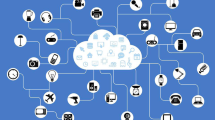Abstract
Underlay device-to-device (D2D) communication in a cellular network is expected to improve spectrum utilization as well as to enable the use of new proximity-based applications. However, deploying D2D communications in a cellular network poses some challenges in the system design due to the potential interference between the cellular links and the D2D links. In this paper, we consider a scenario where a D2D device equipped with multiple antennas attempts to reuse the downlink resources of an active cellular user. Two strategies are proposed to handle the interference that the D2D link may cause to the cellular link. Interference nulling (IN), the first strategy, completely eliminates the interference, while interference constraining (IC), the second strategy, intends to limit the amount of residual interference such that the signal-to-interference-plus-noise ratio (SINR) for the cellular user is ensured to be higher than a certain threshold. Both methods do not produce additional overhead at the base station (BS), since the D2D side autonomously determines the transmit signals without involvement of the BS. The results of a numerical analysis are then presented to compare the performance of these two strategies under various environments.




Similar content being viewed by others
Notes
We set up the parameters based on the following criteria: (1) all nodes are equipped with multiple antennas. (2) The number of antennas at the BS is higher than that at every UE. (3) The D2D-TX is equipped with more antennas than CUE to meet the nulling condition of the IN strategy.
References
3GPP TE 22.803 V1.0.0. (2012). 3rd generation partnership project; technical specification group SA; feasibility study for proximity services (ProSe) (release 12). Technical report.
Corson, M. S., Laroia, R., Li, J., Park, V., Richardson, T., & Tsirtsis, G. (2010). Toward proximity-aware internetworking. IEEE Wireless Communications, 17(6), 26–33.
Lei, L., Zhong, Z., Lin, C., & Shen, X. (2012). Operator controlled device-to-device communications in LTE-advanced networks. IEEE Wireless Communications, 19(3), 96–104.
Doumi, T., Dolan, M. F., Tatesh, S., Casati, A., Tsirtsis, G., Anchan, K., et al. (2013). LTE for public safety networks. IEEE Communications Magazine, 51(2), 106–113.
Doppler, K., Rinne, M., Wijting, C., Ribeiro, C. B., & Hugl, K. (2009). Device-to-device communication as an underlay to LTE-advanced networks. IEEE Communications Magazine, 47(12), 42–49.
Wang, D., Wang, W., Wang, X., & Li, M. (2017). Interference cancellation and adaptive demodulation mapping schemes for device-to-device multicast uplink underlaying cellular networks. Wireless Personal Communications, 95(2), 891–913.
Xujie, L., Ziya, W., Ying, S., Yan, G., & Jurong, H. (2017). Mathematical characteristics of uplink and downlink interference regions in D2D communications underlaying cellular networks. Wireless Personal Communications, 93(4), 917–932.
Fodor, G., Dahlman, E., Mildh, G., Parkvall, S., Reider, N., Miklos, G., et al. (2012). Design aspects of network assisted device-to-device communications. IEEE Communications Magazine, 50(3), 170–177.
Doppler, K., Rinne, M., Wijting, C., Ribeiro, C. B., & Hugl, K. (2009). Device-to-device communication as an underlay to LTE-advanced networks. IEEE Communications Magazine, 47(12), 42–49.
Yu, C. H., Tirkkonen, O., Doppler, K., & Ribeiro, C. (2009). Power optimization of device-to-device communication underlaying cellular communication. In Proceedings of IEEE international conference on communications (ICC 2009), pp. 1–5.
Yu, C. H., Tirkkonen, O., Doppler, K., & Ribeiro, C. (2009). On the performance of device-to-device underlay communication with simple power control. In Proceedings of IEEE vehicular technology conference (VTC 2009 Spring), pp. 1–5.
Wang, H., & Chu, X. (2012). Distance-constrained resource-sharing criteria for device-to-device communications underlaying cellular networks. Electronics Letters, 48(9), 528–530.
Telatar, I. E. (1999). Capacity of multi-antenna Gaussian channels. European Transactions on Telecommunications, 10(6), 585–595.
Tang, H., Zhu, C., & Ding, Z. (2013). Cooperative MIMO precoding for D2D underlay in cellular networks. In Proceedings of IEEE international conference on communications (ICC 2013), pp. 5517–5521.
Zhu, D., Xu, W., Zhang, H., Zhao, C., Li, J. C. F., & Lei, M. (2013). Rate-maximized transceiver optimization for multi-antenna device-to-device communications. In Proceedings of IEEE wireless communications and networking conference (WCNC 2013), pp. 4152–4157.
Janis, P., Koivunen, V., Ribeiro, C. B., Doppler, K., & Hugl, K. (2009). Interference-avoiding MIMO schemes for device-to-device radio underlaying cellular networks. In Proceedings of IEEE international symposium on personal, indoor and mobile radio communications (PIMRC 2009), pp. 2385–2389.
Xu, W., Liang, L., Zhang, H., Jin, S., Li, J. C. F., & Lei, M. (2012) Performance enhanced transmission in device-to-device communications: Beamforming or interference cancellation? In Proceedings of IEEE global communications conference (GLOBECOM 2012), pp. 4296–4301.
Fu, W., Yao, R., Gao, F., Li, J. C. F., & Lei, M. (2013) Robust null-space based interference avoiding scheme for D2D communication underlaying cellular networks. In Proceedings of IEEE wireless communications and networking conference (WCNC 2013), pp. 4158–4162.
Tse, D., & Viswanath, P. (2005). Fundamentals of wireless communication. Cambridge: Cambridge University Press.
Boyd, S., & Vandenberghe, L. (2004). Convex optimization. Cambridge: Cambridge University Press.
Trefethen, L. M., & Bau, D. (1997). Numerical linear algebra. Philadelphia, PA: SIAM.
Cover, T. M., & Thomas, J. A. (1991). Elements of information theory. New York, NY: Wiley.
3GPP TR 36.942 V11.0.0. (2012). 3rd generation partnership project; technical specification group RAN; evolved universal terrestrial radio access; radio frequency (RF) system scenarios (release 11). Technical report.
Acknowledgements
This work was supported by Institute for Information & Communications Technology Promotion (IITP) grant funded by the Korean government (MSIT) (No. 2017-0-00724, Development of Beyond 5G Mobile Communication Technologies (Ultra-Reliable, Low-Latency, and Massive Connectivity) and Combined Access Technologies for Cellular-based Industrial Automation Systems).
Author information
Authors and Affiliations
Corresponding author
Rights and permissions
About this article
Cite this article
Dinh-Van, S., Nguyen, VD. & Shin, OS. Interference-Aware Transmission for D2D Communications in a Cellular Network. Wireless Pers Commun 98, 1489–1503 (2018). https://doi.org/10.1007/s11277-017-4928-2
Published:
Issue Date:
DOI: https://doi.org/10.1007/s11277-017-4928-2




